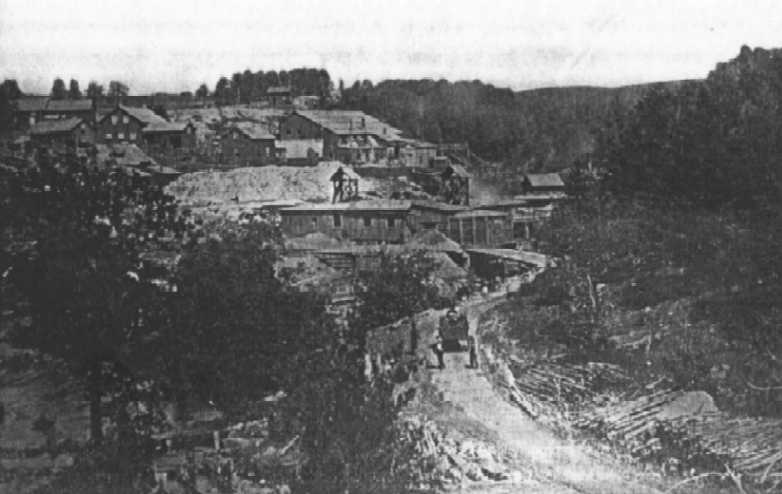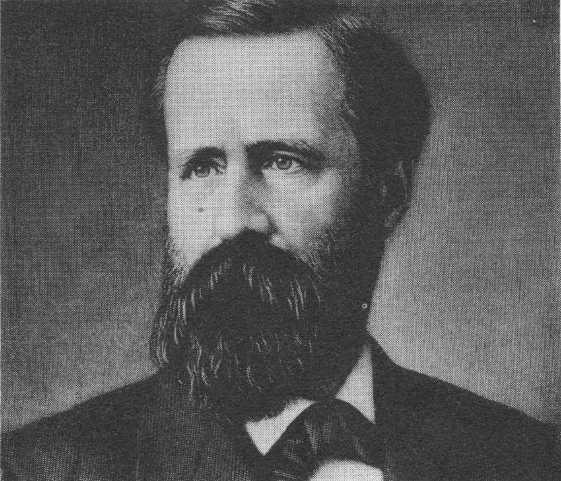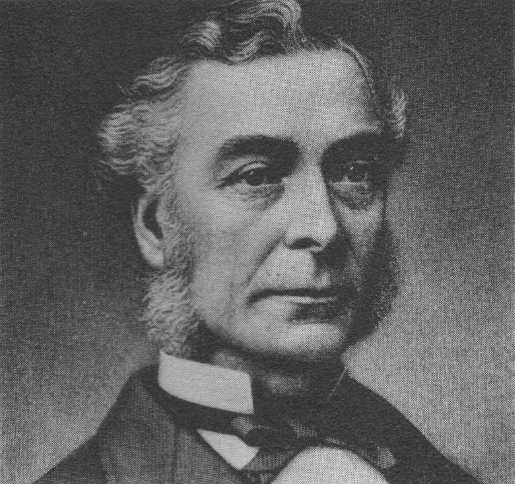Mining for Souls
Page 41
 DEVELOPMENT OF LYON MOUNTAIN, N Y. AS A MINING ENTERPRISE
DEVELOPMENT OF LYON MOUNTAIN, N Y. AS A MINING ENTERPRISE
 Early 19th century ore separator in Adirondacks.
[adk19th.jpg = larger picture]
Picture from History of Mining
of Chateaugay Ore and Iron Company
Early 19th century ore separator in Adirondacks.
[adk19th.jpg = larger picture]
Picture from History of Mining
of Chateaugay Ore and Iron Company
In 1803 William Bailey erected a Catalan forge
on the Chateaugay River about five miles below the outlet of Chateaugay
Lake He obtained his ore from what later became known as the Prall vein
of the 81 mine of the Chateaugay ore bed. The land area comprising the abandoned
Prall vein and what was to become the Chateaugay ore bed was purchased by
Lloyd N. Rogers in 1832. The actual discovery of the Chateaugay ore body
is credited to a trapper named Collins in 1823.
 Smith M. Weed - One of founders of Chateaugay Ore and Iron Co.
Smith M. Weed - One of founders of Chateaugay Ore and Iron Co.
 Andrew Williams - One of founders of Chateaugay Ore and Iron Co.
Andrew Williams and Smith M. Weed were the founders
of the Chateaugay Ore and Iron Company. They obtained control of the property
from Lloyd Rogers' son in 1868 and mined ore in summer months to be moved
during winter by horse drawn sleighs through the dense wilderness to Catalan
forges on the Saranac River. Transportation was a serious problem
for many years but the output from the ore bed grew and by 1874 twenty Catalan
forges together with charcoal kilns were erected at the outlet of Chateaugay
Lake. All the wood, coal and ore were moved on the lake in barges hauled
by steamboat in summer and by horses and sleds over the snow in winter.
The blooms and billets of iron produced from the forge operations were hauled
by wagons and sleighs to Chateaugay and shipped via the Ogdensburg and Lake
Champlain Railroad to Pennsylvania and Ohio steel mills.
Andrew Williams - One of founders of Chateaugay Ore and Iron Co.
Andrew Williams and Smith M. Weed were the founders
of the Chateaugay Ore and Iron Company. They obtained control of the property
from Lloyd Rogers' son in 1868 and mined ore in summer months to be moved
during winter by horse drawn sleighs through the dense wilderness to Catalan
forges on the Saranac River. Transportation was a serious problem
for many years but the output from the ore bed grew and by 1874 twenty Catalan
forges together with charcoal kilns were erected at the outlet of Chateaugay
Lake. All the wood, coal and ore were moved on the lake in barges hauled
by steamboat in summer and by horses and sleds over the snow in winter.
The blooms and billets of iron produced from the forge operations were hauled
by wagons and sleighs to Chateaugay and shipped via the Ogdensburg and Lake
Champlain Railroad to Pennsylvania and Ohio steel mills.
In the years immediately preceding the first
World War a well-defined study of the property was made, including a magnetometric
and geological survey, diamond drilling, chemical analysis, and surveying
and mapping the mine workings. The results revealed that the Chateaugay
ore beds were tremendous in size, containing an almost endless supply of
iron ore practically free from sulphur and phosphorus. So, in 1914,
plans were made for the development of the ore body on a large scale, which
included a new hoisting shaft, 1600 feet deep, with steel headframe and modern
electrically-driven hoisting equipment. War demands on production forced
postponement of development work until 1919. The No. 1 shaft which
had been sunk to a depth of 900 ft., was then extended to a depth of 1685
ft., with four compartments; one for pipe and ladderways, one for men and
supplies and two for hoisting ore, all enclosed in steel and concrete. Levels
and stopes were opened up, electric locomotives installed, and by 1924 all
mining operations were confined to the new No. 1 shaft.
continued on Page 2 of Mining History
Sources:
Adirondack Museum photos, Blue Mountain Lake, NY;
History of Clinton County, New York;
from History of Mining of Chateaugay
Ore and Iron Company.
Go to Page 1 of The History of Lyon
Mountain.
Go to Page 3 of The History of
Lyon Mountain.
Go to Mining History for The
History of Mining in the North Country.
Go to Page 5 of The History of Lyon
Mountain.(for article on Lyon Mt. and Mineville)
Go to Page 42 of Mining for Souls.
Back to Page 40 of Mining for
Souls.
Go to Page 1 of Mining for Souls.(cover
page)
 Rod Bigelow
Box 13 Chazy Lake
Rod Bigelow
Box 13 Chazy Lake
Dannemora, N.Y. 12929
 rodbigelow@netzero.net
rodbigelow@netzero.net  BACK TO
THE HISTORY PAGE
BACK TO
THE HISTORY PAGE
 BACK TO
BIGELOW HOME PAGE
BACK TO
BIGELOW HOME PAGE





